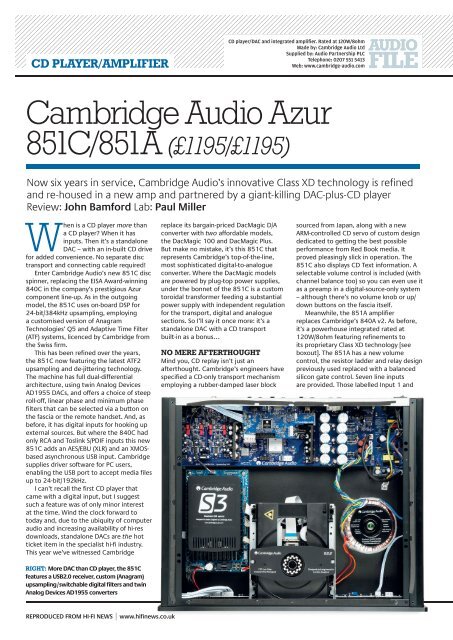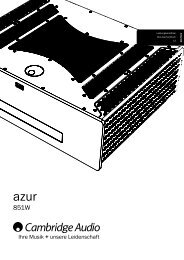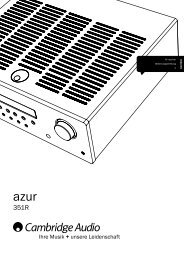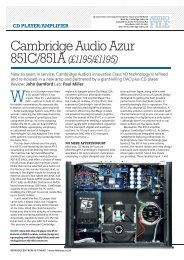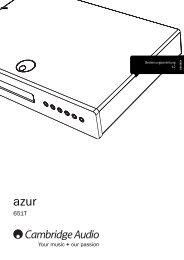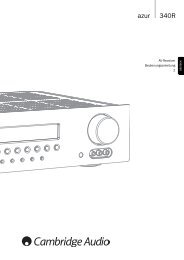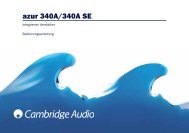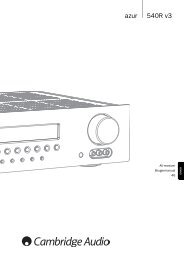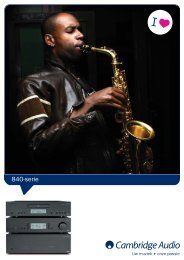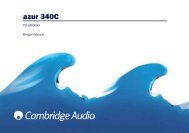Frankly, the feature set of the 851C and 851A is ... - Cambridge Audio
Frankly, the feature set of the 851C and 851A is ... - Cambridge Audio
Frankly, the feature set of the 851C and 851A is ... - Cambridge Audio
Create successful ePaper yourself
Turn your PDF publications into a flip-book with our unique Google optimized e-Paper software.
CD PLAYER/AMPLIFIER<br />
CD player/DAC <strong>and</strong> integrated amplifier. Rated at 120W/8ohm<br />
Made by: <strong>Cambridge</strong> <strong>Audio</strong> Ltd<br />
Supplied by: <strong>Audio</strong> Partnership PLC<br />
Telephone: 0207 551 5413<br />
Web: www.cambridge-audio.com<br />
<strong>Cambridge</strong> <strong>Audio</strong> Azur<br />
<strong>851C</strong>/<strong>851A</strong> (£1195/£1195)<br />
Now six years in service, <strong>Cambridge</strong> <strong>Audio</strong>’s innovative Class XD technology <strong>is</strong> refined<br />
<strong>and</strong> re-housed in a new amp <strong>and</strong> partnered by a giant-killing DAC-plus-CD player<br />
Review: John Bamford Lab: Paul Miller<br />
When <strong>is</strong> a CD player more than<br />
a CD player? When it has<br />
inputs. Then it’s a st<strong>and</strong>alone<br />
DAC – with an in-built CD drive<br />
for added convenience. No separate d<strong>is</strong>c<br />
transport <strong>and</strong> connecting cable required!<br />
Enter <strong>Cambridge</strong> <strong>Audio</strong>’s new <strong>851C</strong> d<strong>is</strong>c<br />
spinner, replacing <strong>the</strong> EISA Award-winning<br />
840C in <strong>the</strong> company’s prestigious Azur<br />
component line-up. As in <strong>the</strong> outgoing<br />
model, <strong>the</strong> <strong>851C</strong> uses on-board DSP for<br />
24-bit/384kHz upsampling, employing<br />
a custom<strong>is</strong>ed version <strong>of</strong> Anagram<br />
Technologies’ Q5 <strong>and</strong> Adaptive Time Filter<br />
(ATF) systems, licenced by <strong>Cambridge</strong> from<br />
<strong>the</strong> Sw<strong>is</strong>s firm.<br />
Th<strong>is</strong> has been refined over <strong>the</strong> years,<br />
<strong>the</strong> <strong>851C</strong> now featuring <strong>the</strong> latest ATF2<br />
upsampling <strong>and</strong> de-jittering technology.<br />
The machine has full dual-differential<br />
architecture, using twin Analog Devices<br />
AD1955 DACs, <strong>and</strong> <strong>of</strong>fers a choice <strong>of</strong> steep<br />
roll-<strong>of</strong>f, linear phase <strong>and</strong> minimum phase<br />
filters that can be selected via a button on<br />
<strong>the</strong> fascia or <strong>the</strong> remote h<strong>and</strong><strong>set</strong>. And, as<br />
before, it has digital inputs for hooking up<br />
external sources. But where <strong>the</strong> 840C had<br />
only RCA <strong>and</strong> Toslink S/PDIF inputs th<strong>is</strong> new<br />
<strong>851C</strong> adds an AES/EBU (XLR) <strong>and</strong> an XMOSbased<br />
asynchronous USB input. <strong>Cambridge</strong><br />
supplies driver s<strong>of</strong>tware for PC users,<br />
enabling <strong>the</strong> USB port to accept media files<br />
up to 24-bit/192kHz.<br />
I can’t recall <strong>the</strong> first CD player that<br />
came with a digital input, but I suggest<br />
such a <strong>feature</strong> was <strong>of</strong> only minor interest<br />
at <strong>the</strong> time. Wind <strong>the</strong> clock forward to<br />
today <strong>and</strong>, due to <strong>the</strong> ubiquity <strong>of</strong> computer<br />
audio <strong>and</strong> increasing availability <strong>of</strong> hi-res<br />
downloads, st<strong>and</strong>alone DACs are <strong>the</strong> hot<br />
ticket item in <strong>the</strong> special<strong>is</strong>t hi-fi industry.<br />
Th<strong>is</strong> year we’ve witnessed <strong>Cambridge</strong><br />
replace its bargain-priced DacMagic D/A<br />
converter with two affordable models,<br />
<strong>the</strong> DacMagic 100 <strong>and</strong> DacMagic Plus.<br />
But make no m<strong>is</strong>take, it’s th<strong>is</strong> <strong>851C</strong> that<br />
represents <strong>Cambridge</strong>’s top-<strong>of</strong>-<strong>the</strong>-line,<br />
most soph<strong>is</strong>ticated digital-to-analogue<br />
converter. Where <strong>the</strong> DacMagic models<br />
are powered by plug-top power supplies,<br />
under <strong>the</strong> bonnet <strong>of</strong> <strong>the</strong> <strong>851C</strong> <strong>is</strong> a custom<br />
toroidal transformer feeding a substantial<br />
power supply with independent regulation<br />
for <strong>the</strong> transport, digital <strong>and</strong> analogue<br />
sections. So I’ll say it once more: it’s a<br />
st<strong>and</strong>alone DAC with a CD transport<br />
built-in as a bonus…<br />
NO MERE AFTERTHOUGHT<br />
Mind you, CD replay <strong>is</strong>n’t just an<br />
afterthought. <strong>Cambridge</strong>’s engineers have<br />
specified a CD-only transport mechan<strong>is</strong>m<br />
employing a rubber-damped laser block<br />
sourced from Japan, along with a new<br />
ARM-controlled CD servo <strong>of</strong> custom design<br />
dedicated to getting <strong>the</strong> best possible<br />
performance from Red Book media. It<br />
proved pleasingly slick in operation. The<br />
<strong>851C</strong> also d<strong>is</strong>plays CD Text information. A<br />
selectable volume control <strong>is</strong> included (with<br />
channel balance too) so you can even use it<br />
as a preamp in a digital-source-only system<br />
– although <strong>the</strong>re’s no volume knob or up/<br />
down buttons on <strong>the</strong> fascia itself.<br />
Meanwhile, <strong>the</strong> <strong>851A</strong> amplifier<br />
replaces <strong>Cambridge</strong>’s 840A v2. As before,<br />
it’s a powerhouse integrated rated at<br />
120W/8ohm featuring refinements to<br />
its proprietary Class XD technology [see<br />
boxout]. The <strong>851A</strong> has a new volume<br />
control, <strong>the</strong> res<strong>is</strong>tor ladder <strong>and</strong> relay design<br />
previously used replaced with a balanced<br />
silicon gate control. Seven line inputs<br />
are provided. Those labelled Input 1 <strong>and</strong><br />
RIGHT: More DAC than CD player, <strong>the</strong> <strong>851C</strong><br />
<strong>feature</strong>s a USB2.0 receiver, custom (Anagram)<br />
upsampling/switchable digital filters <strong>and</strong> twin<br />
Analog Devices AD1955 converters<br />
REPRODUCED FROM HI-FI NEWS | www.hifinews.co.uk
Input 2 have both single-ended (RCA) <strong>and</strong><br />
balanced (XLR) connections. There’s a tape<br />
in/out as well. Selecting Input 1 (or Input<br />
2) chooses its RCA input, while selecting<br />
it a second time switches to its XLR input.<br />
Consequently you could<br />
connect ten sources to<br />
<strong>the</strong> <strong>851A</strong> – enough for<br />
most <strong>of</strong> us, surely!<br />
The <strong>851A</strong>’s second<br />
balanced input has<br />
replaced <strong>the</strong> multiroom<br />
connectivity <strong>of</strong><br />
<strong>the</strong> outgoing 840A,<br />
although custom installations are still<br />
catered for by RS232 <strong>and</strong> IR ports, while<br />
two <strong>set</strong>s <strong>of</strong> speaker terminals provide A/B/<br />
A+B switching. O<strong>the</strong>r niceties include<br />
input gain trim <strong>and</strong> selectable bass <strong>and</strong><br />
‘Th<strong>is</strong> Azur combo<br />
took me to places<br />
I haven’t been for<br />
a long time!’<br />
CROSSOVER DISPLACEMENT<br />
treble controls that can be <strong>set</strong> individually<br />
for each input via a configuration menu.<br />
A preamp output (single-ended only) <strong>is</strong><br />
included; moreover, any <strong>of</strong> <strong>the</strong> inputs can<br />
be configured as a power amp input <strong>and</strong> its<br />
fixed level custom-<strong>set</strong>.<br />
Inputs can be named on<br />
both <strong>the</strong> amplifier <strong>and</strong><br />
<strong>the</strong> <strong>851C</strong> DAC/player.<br />
<strong>Frankly</strong>, <strong>the</strong><br />
<strong>feature</strong>-<strong>set</strong> <strong>of</strong> <strong>the</strong> <strong>851C</strong><br />
<strong>and</strong> <strong>851A</strong> <strong>is</strong> <strong>the</strong> stuff <strong>of</strong><br />
high-end audio dreams,<br />
but packaged in sensiblypriced<br />
components thanks to economies<br />
<strong>of</strong> scale in <strong>Cambridge</strong>’s Far Eastern<br />
manufacturing. They’re more expensive<br />
than <strong>the</strong> products <strong>the</strong>y replace, but chass<strong>is</strong><br />
<strong>and</strong> bonnet construction <strong>is</strong> a little sturdier<br />
Class A <strong>is</strong> <strong>the</strong> sledgehammer approach to eliminating crossover d<strong>is</strong>tortion –<br />
caused by <strong>the</strong> music signal crossing from positive to negative-going (or viceversa)<br />
<strong>and</strong> one or more trans<strong>is</strong>tors momentarily switching <strong>of</strong>f. In Class A <strong>the</strong><br />
complementary pairs <strong>of</strong> output trans<strong>is</strong>tors always have sufficient st<strong>and</strong>ing<br />
current to ensure <strong>the</strong>y remain conducting at all times, but <strong>the</strong> devices run hot<br />
<strong>and</strong> <strong>the</strong> implementation <strong>is</strong> very costly. <strong>Cambridge</strong>’s elegant Class XD alternative<br />
doesn’t eliminate crossover d<strong>is</strong>tortion, it simply shifts it away from <strong>the</strong> zerocrossing<br />
point <strong>of</strong> <strong>the</strong> waveform – hence <strong>the</strong> name ‘Crossover D<strong>is</strong>placement’<br />
or XD. Class XD tracks <strong>the</strong> audio signal <strong>and</strong> applies a negative bias current,<br />
<strong>of</strong>f<strong>set</strong>ting <strong>the</strong> position <strong>of</strong> <strong>the</strong> crossover point without creating a DC <strong>of</strong>f<strong>set</strong>.<br />
At low signal levels <strong>the</strong> crossover point <strong>is</strong> shifted below <strong>the</strong> maximum<br />
negative swing <strong>of</strong> <strong>the</strong> audio waveform, yielding all <strong>the</strong> benefits <strong>of</strong> pure Class A.<br />
At higher signal levels <strong>the</strong> <strong>of</strong>f<strong>set</strong> crossover point falls within <strong>the</strong> negative cycle<br />
<strong>of</strong> <strong>the</strong> music waveform – <strong>the</strong>re’s <strong>the</strong> same number <strong>of</strong> ‘transitions’ but <strong>the</strong> nature<br />
<strong>of</strong> <strong>the</strong> d<strong>is</strong>tortion <strong>is</strong> more easily accommodated by negative feedback. Finally, if<br />
Class XD sounds ra<strong>the</strong>r like <strong>the</strong> sliding bias regimes popular with Japanese amps<br />
<strong>of</strong> yore, it’s not, for where <strong>the</strong> latter applied a symmetrical shift in bias Class XD<br />
applies an asymmetric (negative) shift. PM<br />
ABOVE: S<strong>of</strong>t-touch controls <strong>and</strong> a wealth <strong>of</strong><br />
o<strong>the</strong>r functions added by <strong>the</strong> matching remote<br />
h<strong>and</strong><strong>set</strong> [see p31], but <strong>the</strong> back-lit d<strong>is</strong>plays do<br />
not quite match in style, brightness or colour<br />
than before <strong>and</strong> <strong>the</strong>y have improved LCD<br />
d<strong>is</strong>plays that provide better contrast <strong>and</strong> a<br />
wider viewing angle for improved legibility.<br />
HARD TO FAULT<br />
Used to drive <strong>the</strong> Monitor <strong>Audio</strong> PL100<br />
st<strong>and</strong>mounts reviewed th<strong>is</strong> month [p56],<br />
<strong>the</strong> <strong>Cambridge</strong> combo sounded deliciously<br />
insightful, <strong>the</strong> ‘open’ <strong>and</strong> ultra-vivid<br />
PL100s showcasing <strong>the</strong> transparency <strong>of</strong><br />
<strong>the</strong> upstream source player <strong>and</strong> amplifier.<br />
The speakers’ fabulous ribbon tweeters<br />
(with almost 100kHz range) revealed <strong>the</strong><br />
smooth refinement <strong>of</strong> <strong>the</strong> <strong>Cambridge</strong> duo,<br />
instruments <strong>and</strong> voices <strong>set</strong> against an eerily<br />
silent background <strong>and</strong> clearly differentiated<br />
even in dense sound mixes.<br />
I threw a bunch <strong>of</strong> familiar audiophile<br />
‘reference’ recordings at th<strong>is</strong> combo. All<br />
<strong>the</strong> usual suspects: Diana Krall’s ‘My Love<br />
Is’ from Love Scenes [Impulse IMP12342];<br />
Dire Straits’ ‘Private Investigations’ from<br />
Love Over Gold [1996 remaster, Mercury<br />
8000882]; various tracks by Patricia<br />
Barber… you get <strong>the</strong> picture. What <strong>the</strong>y<br />
proved was that <strong>the</strong>se components are<br />
more than merely competent, ra<strong>the</strong>r<br />
<strong>the</strong>y deliver truly excellent sound that<br />
challenges products costing megabucks.<br />
They seem to tell it like it <strong>is</strong>, revealing<br />
texture, ‘character’ <strong>and</strong> space in recordings<br />
without imparting an obvious sonic<br />
thumbprint <strong>of</strong> <strong>the</strong>ir own.<br />
Imaging was tremendous, Patricia<br />
Barber’s piano remaining rock-solid in<br />
its location in <strong>the</strong> soundstage with no<br />
www.hifinews.co.uk | REPRODUCED FROM HI-FI NEWS
LAB<br />
REPORT<br />
ABOVE: Matching balanced (XLR) <strong>and</strong> single-ended (RCA) connections are joined by a<br />
suite <strong>of</strong> USB <strong>and</strong> S/PDIF inputs on <strong>the</strong> player with two <strong>set</strong>s <strong>of</strong> speaker outs on <strong>the</strong> amp<br />
smearing <strong>of</strong> focus during dynamic<br />
shifts in her playing. With top drawer<br />
recordings, <strong>the</strong> <strong>Cambridge</strong> combo<br />
allowed you to enjoy a great sense<br />
<strong>of</strong> depth <strong>and</strong> detail.<br />
ENTER SIR GALAHAD<br />
Muting <strong>the</strong> amp, I d<strong>is</strong>connected<br />
<strong>the</strong> PL100 speakers to hook up my<br />
towering Townshend Sir Galahads<br />
[see www.hifinews.co.uk/news/<br />
article.asp?a=9884]. Ridiculous?<br />
Using such ‘humble’ components as<br />
<strong>the</strong> 851s to drive thirty-odd gr<strong>and</strong>s’<br />
worth <strong>of</strong> high-end monitors? Well<br />
I kid you not, but I was taken to<br />
places I haven’t been to for a long<br />
time by th<strong>is</strong> <strong>Cambridge</strong> combo!<br />
Playing ‘Bop’ from The Br<strong>and</strong>t Brauer<br />
Frick Ensemble’s Mr Machine album<br />
[!K7 Records K7286CD] highlighted<br />
<strong>the</strong> amplifier’s immense power<br />
reserves <strong>and</strong> confidence.<br />
Th<strong>is</strong> galloping, Steve Reich-esque<br />
composition lays out a hypnotic,<br />
electronica-type backdrop <strong>of</strong><br />
piano <strong>and</strong> drums between <strong>the</strong><br />
speakers. Against th<strong>is</strong>, startling<br />
percussive elements leap out <strong>of</strong> <strong>the</strong><br />
mix. Nothing seemed to faze <strong>the</strong><br />
<strong>Cambridge</strong> duo: <strong>the</strong> cracking sounds<br />
<strong>of</strong> wood blocks <strong>and</strong> bells ricocheted<br />
around <strong>the</strong> l<strong>is</strong>tening room; leading<br />
edges <strong>of</strong> transients appeared fast<br />
<strong>and</strong> dynamic. All <strong>the</strong> while <strong>the</strong><br />
position <strong>of</strong> <strong>the</strong> piano <strong>and</strong> drums<br />
never wavered in <strong>the</strong> image – even<br />
later on when syn<strong>the</strong>sizer sound<br />
effects delivered shockwaves <strong>of</strong><br />
bass energy in th<strong>is</strong> eclectic marriage<br />
<strong>of</strong> electronic dance music with<br />
sampled classical instruments.<br />
No matter how challenging <strong>the</strong><br />
music, <strong>the</strong> system kept a tight grip<br />
on proceedings while appearing<br />
calm <strong>and</strong> unflustered. I mixed<br />
<strong>and</strong> matched <strong>the</strong> 851s with o<strong>the</strong>r<br />
components to assess individual<br />
merit. I concluded that <strong>the</strong> amp<br />
<strong>is</strong> explicit <strong>and</strong> vivacious, sounding<br />
open-mou<strong>the</strong>d <strong>and</strong> airy while also<br />
delivering <strong>the</strong> sort <strong>of</strong> stellar bass<br />
common to solid-state muscle amps<br />
such as big Brystons <strong>and</strong> <strong>the</strong> like.<br />
It’s <strong>the</strong> <strong>851C</strong> DAC/player that<br />
brings a quiet composure to <strong>the</strong><br />
party, sounding subjectively ‘dark’<br />
if a little dry <strong>and</strong> matter-<strong>of</strong>-fact.<br />
Although it would be churl<strong>is</strong>h to<br />
critic<strong>is</strong>e it, I could describe it as<br />
slightly soulless <strong>and</strong> lacking charm.<br />
But th<strong>is</strong> would be in absolute terms,<br />
comparing it against cost-noobject<br />
audio esoterica. Whe<strong>the</strong>r<br />
unintentionally or by design,<br />
however, <strong>the</strong> 851 combination <strong>is</strong> a<br />
marriage made in heaven.<br />
The <strong>851A</strong> <strong>is</strong> a wolf in sheep’s<br />
clothing, a muscular amp that<br />
grips <strong>the</strong> speakers <strong>and</strong> serves up<br />
tight, powerful <strong>and</strong> extended bass.<br />
Torture tracks such as Grace Jones’<br />
famous ‘Slave To The Rhythm’ or<br />
‘Big Wheels In Shanty Town’ from<br />
David Sylvian’s Rain Tree Crow<br />
[Virgin CDV 2659] were h<strong>and</strong>led<br />
with aplomb, bass lines reproduced<br />
with gusto while midrange <strong>and</strong> high<br />
frequencies remained pol<strong>is</strong>hed <strong>and</strong><br />
squeaky-clean thanks to that quiet<br />
composure <strong>of</strong> <strong>the</strong> <strong>851C</strong> source.<br />
HI-FI NEWS VERDICT<br />
If ever <strong>the</strong>re was a combo<br />
deserving <strong>of</strong> gar<strong>is</strong>h ‘Buy Me’<br />
stickers on <strong>the</strong> fascias it’s <strong>the</strong>se<br />
latest Azur components. As <strong>is</strong> so<br />
<strong>of</strong>ten <strong>the</strong> case with products from<br />
<strong>Cambridge</strong> <strong>Audio</strong>, what you’re<br />
getting in <strong>the</strong> <strong>851C</strong> <strong>and</strong> <strong>851A</strong><br />
<strong>is</strong> cutting-edge technology for<br />
substantially less than high-end<br />
prices. Add <strong>the</strong> best speakers you<br />
can afford <strong>and</strong> th<strong>is</strong> CD/DAC <strong>and</strong><br />
amplifier will deliver a taste <strong>of</strong><br />
hi-fi heaven.<br />
Sound Quality: 86%<br />
0 - - - - - - - - 100<br />
CAMBRIDGE AUDIO <strong>851C</strong>/A (£1195 ea)<br />
While <strong>the</strong> <strong>851A</strong> amplifier <strong>is</strong> clearly a refined version <strong>of</strong> <strong>the</strong> 840A<br />
[HFN, Jun ’06], <strong>the</strong> <strong>851C</strong> CD player/DAC <strong>is</strong> a new design. Its<br />
performance as an outboard DAC <strong>is</strong> first rate, supporting inputs<br />
up to 24-bit/192kHz via S/PDIF <strong>and</strong> USB with no downsampling<br />
while maintaining a cons<strong>is</strong>tent 112.5dB A-wtd S/N ratio.<br />
Responses are influenced by choice <strong>of</strong> filter (<strong>the</strong> Minimum filter<br />
has <strong>the</strong> biggest impact in <strong>the</strong> time domain with its exclusively<br />
post-event echo) but <strong>the</strong>y are typically –0.08dB/20kHz<br />
(44.1/48kHz), –1dB/45kHz (96kHz) <strong>and</strong> –2.9dB/90kHz (192kHz<br />
sources). Jitter <strong>is</strong> fabulously low at 117psec (<strong>the</strong> limit <strong>of</strong><br />
measurement with 16-bit CD) <strong>and</strong> typically


